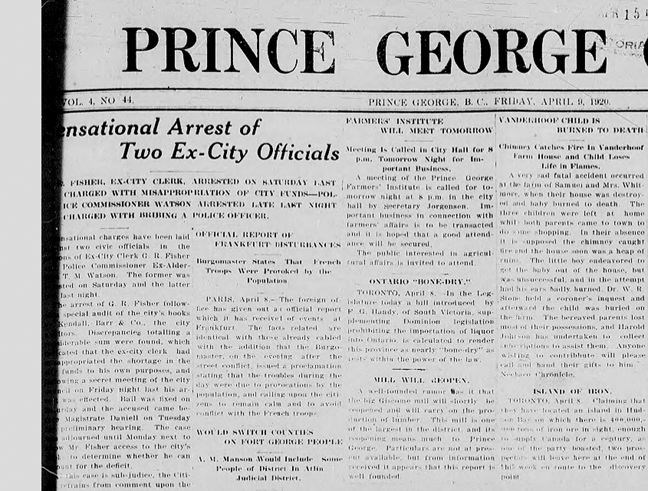This week in Prince George history, April 3-9:
April 9, 1920: Two former city officials were under arrest and facing charges, The Citizen reported.
Former city clerk G.R. Fisher, and serving police commission member, was arrested on April 3 after a special audit of the city's books was conducted, the report said.
"Discrepancies totaling a considerable sum of money were found, which indicated that the the ex-city clerk had misappropriated the shortage in the city funds to his own purposes, and following a secret meeting of the city council on Friday night last his arrest was effected," The Citizen reported.
The Citizen reported from "reliable sources" that a representative for Fisher had looked over the books and found some of the missing sums had been improperly accounted.
"Incompetence upon the part of the accused is held to be the cause of these errors and entries... although there remains a considerable sum still to be accounted for."
Fisher was a returned veteran and had served the city in 1919, before being discharged by Mayor Perry shortly after he took office.
Former city alderman T.M. Watson, who was an elected member of the city's police commission, was also facing charges after being arrested on April 8. Watson was accused of attempting to bride a police officer, however The Citizen had few details to report.
This is the one case where the curmudgeons grumping about everyone at city hall being a bunch of crooks were actually correct.
April 4, 1929: "Repeatedly tales of a new king, acclaimed by his 10,000 black subjects on his island of La Gonave, 30 miles from Port-au-Prince, Haiti, have reached the travel bureau of the Cunard Canadian head offices (in Montreal)," The Citizen reported. "He was recently toasted and presented with gifts, when he betook his royal self, robed and with crown, to visit the cruising passengers of the Anchor liner Californian.
"In brief the story is this. Several years ago, top-sergeant Wirkus, of the United States Marines, later King Faustin, was dropped at his own request from an aeroplane to be lieutenant of gendarmerie for La Gonave, (a) protectorate of the United States," The Citizen story added.
Wirkus was crowned king by the people of La Gonave after two or three months on the island, the report added.
"The prestige of His Majesty grows apace," the report concluded.
King Faustin (also known as King Faustin II)'s reign, which began on July 18, 1926, would come to an end later that year when the U.S. Marine Corps transferred him back to the mainland -perhaps after reading this news story. Wirkus co-wrote an autobiographical account of his time on the island called The White King of La Gonave: The True Story of the Sergeant of Marines Who Was Crowned King on a Voodoo Island. In his account, he said he was named king after rescuing Queen Timemenne of La Gonave, and jointly ruled the island with the queen for three years. Marine Corps historian Beth Crumley wrote an account of Wirkus' life and service, which can be found online here.
April 7, 1949: The city faced a trashy situation, as spring melting made "nearly 14 miles of the city's 28-mile-long garbage run" impassable.
"C. East, city engineer, invited a reporter to accompany him on an inspection tour of back lanes," The Citizen reported. "Nearly half the lanes were impassable owing to spring break-up. Garbage accumulating in these muddy, impassable lanes can not be collected the city garbage truck until conditions improve. The truck, which is constantly on duty during the day, cannot risk going into many of these lanes because, if stuck, a whole day may be wasted extracting the vehicle."
East expected the situation to improve in a week.
Note "the truck." Yup, the booming city of Prince George had one whole garbage truck back in 1949.
April 9, 1931: Construction of a bridge over the Nechako River was expected to begin in May, after a Stuart Cameron and Co. Ltd. of Vancouver was awarded the $100,000 contract for the work, The Citizen reported.
"The new bridge is to go in about forty feet up stream from the present structure, and its deck will be nine feet higher than that of the present bridge, to secure a safe elevation over probable ice jams, which will also give a better grade for the approach to the north end," the report said.
The work was expected to employ 40 men and take about five months to complete.
That bridge, of course, would come to be known as the Cameron Street Bridge. It replaced a bridge completed on Nov. 15, 1916, after that bridge was damaged by an ice jam in the winter of 1931. The 1931 bridge would remain in service until September 2005, when the wooden structural members were found to be rotting. The bridge was torn down and a new bridge, finished in August 2009, was built on the existing concrete piers.



